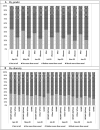Prospective longitudinal study of 'Sleepless in Lockdown': unpacking differences in sleep loss during the coronavirus pandemic in the UK
- PMID: 34980617
- PMCID: PMC8724580
- DOI: 10.1136/bmjopen-2021-053094
Prospective longitudinal study of 'Sleepless in Lockdown': unpacking differences in sleep loss during the coronavirus pandemic in the UK
Abstract
Objectives: COVID-19 is having a disproportionate impact on Black, Asian and minority ethnic (BAME) groups and women. Concern over direct and indirect effects may also impact on sleep. We explore the levels and social determinants of self-reported sleep loss among the UK population during the pandemic, focusing on ethnic and gender disparities.
Setting: This prospective longitudinal study analysed data from seven waves of the Understanding Society: COVID-19 Study collected from April 2020 to January 2021 linked to prepandemic data from the 2019 mainstage interviews, providing baseline information about the respondents prior to the pandemic.
Participants: The analytical sample included 8163 respondents aged 16 and above who took part in all seven waves with full information on sleep loss, defined as experiencing 'rather more' or 'much more' than usual sleep loss due to worry, providing 57 141 observations.
Primary outcome measures: Self-reported sleep loss. Mixed-effects regression models were fitted to consider within-individual and between-individual differences.
Results: Women were more likely to report sleep loss than men (OR 2.1, 95% CI 1.9 to 2.4) over the 10-month period. Being female, having young children, perceived financial difficulties and COVID-19 symptoms were all predictive of sleep loss. Once these covariates were controlled for, the bivariate relationship between ethnicity and sleep loss (1.4, 95% CI 1.6 to 2.4) was reversed (0.7, 95% CI 0.5 to 0.8). Moreover, the strength of the association between gender and ethnicity and the risk of sleep loss varied over time, being weaker among women in July (0.6, 95% CI 0.5 to 0.7), September (0.7, 95% CI 0.6 to 0.8), November (0.8, 95% CI 0.7 to 1.0) and January 2021 (0.8, 95% CI 0.7 to 0.9) compared with April 2020, but positively stronger among BAME individuals in May (1.4, 95% CI 1.0 to 2.1), weaker only in September (0.7, 95% CI 0.5 to 1.0).
Conclusions: The pandemic has widened sleep deprivation disparities, with women with young children, COVID-19 infection and BAME individuals experiencing sleep loss, which may adversely affect their mental and physical health.
Keywords: COVID-19; epidemiology; mental health.
© Author(s) (or their employer(s)) 2022. Re-use permitted under CC BY. Published by BMJ.
Conflict of interest statement
Competing interests: None declared.
Figures


Similar articles
-
Association of Social Determinants of Health and Vaccinations With Child Mental Health During the COVID-19 Pandemic in the US.JAMA Psychiatry. 2022 Jun 1;79(6):610-621. doi: 10.1001/jamapsychiatry.2022.0818. JAMA Psychiatry. 2022. PMID: 35475851 Free PMC article.
-
Psychological Distress Before and During the COVID-19 Pandemic Among Adults in the United Kingdom Based on Coordinated Analyses of 11 Longitudinal Studies.JAMA Netw Open. 2022 Apr 1;5(4):e227629. doi: 10.1001/jamanetworkopen.2022.7629. JAMA Netw Open. 2022. PMID: 35452109 Free PMC article.
-
Covid-19 lockdown: Ethnic differences in children's self-reported physical activity and the importance of leaving the home environment; a longitudinal and cross-sectional study from the Born in Bradford birth cohort study.Int J Behav Nutr Phys Act. 2021 Sep 6;18(1):117. doi: 10.1186/s12966-021-01183-y. Int J Behav Nutr Phys Act. 2021. PMID: 34488785 Free PMC article.
-
The impact of COVID-19 on the changes in health behaviours among Black, Asian and Minority Ethnic (BAME) communities in the United Kingdom (UK): a scoping review.BMC Public Health. 2023 Jul 31;23(1):1466. doi: 10.1186/s12889-023-15978-0. BMC Public Health. 2023. PMID: 37525154 Free PMC article.
-
The impact of COVID-19 on different population subgroups: ethnic, gender and age-related disadvantage.J R Coll Physicians Edinb. 2021 Jun;51(S1):S40-S46. doi: 10.4997/JRCPE.2021.240. J R Coll Physicians Edinb. 2021. PMID: 34185037 Review.
Cited by
-
Impact of COVID-19 lockdown on physical activity, insomnia, and loneliness among Spanish women and men.Sci Rep. 2023 Feb 20;13(1):2912. doi: 10.1038/s41598-023-30173-2. Sci Rep. 2023. PMID: 36804465 Free PMC article.
-
Health behaviors and subsequent mental health problems during the COVID-19 pandemic: A longitudinal analysis of adults in the UK.Front Public Health. 2023 Jan 12;10:1064677. doi: 10.3389/fpubh.2022.1064677. eCollection 2022. Front Public Health. 2023. PMID: 36711346 Free PMC article.
-
Psychopathology in virtual education for primary school students in the COVID-19 pandemic: A qualitative analysis.J Educ Health Promot. 2022 Sep 28;11:289. doi: 10.4103/jehp.jehp_1537_21. eCollection 2022. J Educ Health Promot. 2022. PMID: 36439005 Free PMC article.
-
Overwhelmed by Learning in Lockdown: Effects of Covid-19-enforced Homeschooling on Parents' Wellbeing.Soc Indic Res. 2022;164(1):323-343. doi: 10.1007/s11205-022-02936-3. Epub 2022 Jun 23. Soc Indic Res. 2022. PMID: 35761906 Free PMC article.
-
Poor Sleep during the First Peak of the SARS-CoV-2 Pandemic: A Cross-Sectional Study.Int J Environ Res Public Health. 2021 Jan 4;18(1):306. doi: 10.3390/ijerph18010306. Int J Environ Res Public Health. 2021. PMID: 33406588 Free PMC article.
References
-
- BBC News . Coronavirus: how the UK is sleeping under lockdown. Available: https://www.bbc.co.uk/news/health-52911395 [Accessed 15 Jun 2020].
Publication types
MeSH terms
LinkOut - more resources
Full Text Sources
Medical
Miscellaneous
